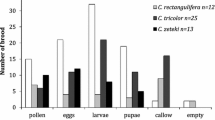Abstract
White-fronted bee-eaters (Merops bullockoides, order Coraciiformes) have one of the most complex societies recorded among birds. These birds are highly gregarious, roosting and breeding in large colonies of up to several hundred individuals. They are also cooperative breeders, with over one-half of all breeding pairs being assisted by one or more helpers at the nest1. Each colony is subdivisible into several smaller, tightly interacting social units, each consisting of several pairs and helpers—these units we term clans. Here we report that each bee-eater clan defends a group foraging territory that may be located as many as 7km from the colony site. Each group territory is subdivided into several partially overlapping home ranges belonging to different members of the clan. These home range clusters remain spatially fixed despite periodic shifts from one colonial roosting and breeding site to another. We suggest that the spatial segregation of feeding territories and breeding colonies may have contributed to the complexity of the societal structure of these birds.
Similar content being viewed by others
References
Emlen, S. T. in Natural Selection and Social Behavior: Recent Research and New Theory (eds Alexander, R. D. & Tinkle, D.) 217–230 (Chiron, New York, 1981).
Brown, J. L. Am. Zool. 14, 63–80 (1974).
Zahavi, A. Ibis 116, 84–87 (1974).
Woolfenden, G. E. Auk 92, 1–15 (1975).
Brown, J. L. & Balda, R. P. Condor 79, 312–320 (1977).
Gaston, A. J. Ibis 120, 415–432 (1978).
Ligon, J. D. & Ligon, S. H. Living Bird 17, 159–197 (1979).
Brown, J. L. A. Rev. Ecol. Syst. 9, 123–155 (1978).
Emlen, S. T. in Behavioural Ecology: An Evolutionary Approach (eds Krebs, J. R. & Davies, N. B.) 245–281 (Blackwell, Oxford, 1978).
Dexter, R. W. Wilson Bull. 64, 133–139 (1952).
Douthwaite, R. J. J. E. Africa Nat. Hist. Soc. 31, 1–12 (1978).
Reyer, H.-U. Behavl Ecol. Sociobiol. 6, 219–227 (1980).
Woolfenden, G. E. & Fitzpatrick, J. W. Bioscience 28, 104–108 (1978).
Gaston, A. J. Am. Nat. 112, 1091–1100 (1978).
Koenig, W. D. & Pitelka, F. A. in Natural Selection and Social Behavior: Recent Research and New Theory (eds Alexander, R. D. & Tinkle, D.) 261–280 (Chiron, New York, 1981).
Emlen, S. T. Am. Nat. 119, 29–39 (1982).
Emlen, S. T. Am. Nat. 119, 40–53 (1982).
Author information
Authors and Affiliations
Rights and permissions
About this article
Cite this article
Hegner, R., Emlen, S. & Demong, N. Spatial organization of the white-fronted bee-eater. Nature 298, 264–266 (1982). https://doi.org/10.1038/298264a0
Received:
Accepted:
Issue Date:
DOI: https://doi.org/10.1038/298264a0
- Springer Nature Limited
This article is cited by
-
A Comparison of Social Organization in Asian Elephants and African Savannah Elephants
International Journal of Primatology (2012)
-
A comparative analysis of some life-history traits between cooperatively and non-cooperatively breeding Australian passerines
Evolutionary Ecology (1994)
-
Parent–offspring conflict and the recruitment of helpers among bee-eaters
Nature (1992)
-
The role of kinship in helping decisions among white-fronted bee-eaters
Behavioral Ecology and Sociobiology (1988)
-
Biochemical determination of parental uncertainty in white-fronted bee-eaters
Behavioral Ecology and Sociobiology (1987)





